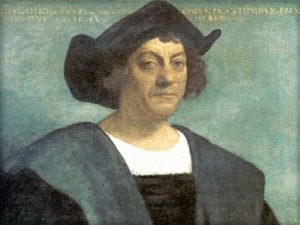Fernando Torres, Jews and Christopher Columbus
 In honour of Columbus Day in the U.S. – Monday, October 14, 2013 – and my passion for football/soccer, I decided to look into one of the most talented football players on earth and his connection with Columbus – Spanish born Fernando Torres. In Liverpool, in the British Premier League, he reached 50 league goals faster than any player in the club’s history. On May 15, 2013, Torres won the UEFA Europa League with Chelsea, joining teammate Juan Mata to become the first players to have held all four of the Champions League, Europa League, World Cup and the European Championships simultaneously. But what does this have to do with Columbus? Well, it has a lot to do with Columbus and the secret reason why he set sail for America. To find out how…you just follow the soccer ball.
In honour of Columbus Day in the U.S. – Monday, October 14, 2013 – and my passion for football/soccer, I decided to look into one of the most talented football players on earth and his connection with Columbus – Spanish born Fernando Torres. In Liverpool, in the British Premier League, he reached 50 league goals faster than any player in the club’s history. On May 15, 2013, Torres won the UEFA Europa League with Chelsea, joining teammate Juan Mata to become the first players to have held all four of the Champions League, Europa League, World Cup and the European Championships simultaneously. But what does this have to do with Columbus? Well, it has a lot to do with Columbus and the secret reason why he set sail for America. To find out how…you just follow the soccer ball.
Recently, I focused on a tennis ball, more specifically the tennis played by the world’s number one tennis player, Rafael Nadal. I pointed out that on both his mother’s and father’s side he is of Jewish i.e., “converso”, background. The conversos are those Jews who some 500 years ago were converted to Christianity in Spain and then ruthlessly pursued by the Inquisition. One of the prominent Jewish families at the time was the Torres family. Some adopted Christianity and stayed in Spain, others fled to various countries and maintained their Jewish faith. Some lived double lives – Christian to the outside world and Jews in the secrecy of their own homes.
I don’t know if Fernando Torres is of Jewish background. What I do know is that Torres is a Jewish/converso name. For example, a famous Spanish dramatist of the 15th century was Bartolome de Torres Naharro. We know for a fact that he was a converso and despite the fact that he took priestly vows to show his commitment to his new faith, the Inquisition put his books on their “indexes” i.e., the list of heretical literature that should be avoided by the faithful. If he is of Jewish background, Fernando Torres is a descendant of those Jews who were forced to abandon their Jewish faith.
But there are also members of the Torres family who did not convert, left Spain and migrated to various corners of the earth. In the US, “Torres” is a Jewish name of Spanish background. Coincidentally, people with this name seem to be good at sports. California born Dara Grace Torres is one of the most celebrated swimmers ever, winning 12 medals at five different Olympics. But then she did the unthinkable. At age 41, just 15 months after she gave birth to her first child, she won gold in the 100-meter freestyle at the U.S. Nationals in Indianapolis. Oddly enough, Fernando and Dara even look alike:

But since this is Columbus Day, and I promised a connection between football/soccer, swimming and Christopher Columbus, I need to talk about a Torres whose achievements have not been celebrated – but should be. His name was Luis de Torres. He was a Jew who, according to legend, was literally converted at the docks before boarding Columbus’ ship. Moviemakers have depicted Columbus’ historical journey to America as an event marked with cheering crowds and women waiving colorful kerchiefs. The reality is that he sailed for the New World on the 9th day of the Jewish month of Av, the saddest day in the Jewish calendar, the day that both the First and Second Temples in Jerusalem were destroyed. It was also the day the Jews of Spain were expelled. Columbus left in the dead of night and to the right and left of him were boats packed with thousands of Jews bidding farewell to families that had been forcibly converted, and the land that had been their home for over 1,000 years.
People think that King Ferdinand and Queen Isabella sponsored Columbus’ voyage. Not so. What they did is give approval for his exploration. Columbus’ journey was totally financed by conversos; Luis de Santangel, Spain’s chancellor of the royal household and Gabriel Sanchez, treasurer of Aragon. On the voyage, Columbus’ navigator and doctor were conversos. More significantly, Columbus’ “translator” was Luis de Torres, mentioned above. Since Columbus was ostensibly sailing for India, you would think he’d have a translator who spoke Hindi. But Louis de Torres spoke no Hindi, his specialty was Hebrew.
Why would Columbus take a Hebrew speaker with him on a voyage to the New World? Because, according to Simon Wiesenthal in his book “Sails of Hope”, Columbus wasn’t looking for India. Rather, his secret mission was to find the lost tribes of Israel. After all, the Jews were experiencing unprecedented persecution in Europe and legend had it that across a mythical body of water the lost tribes of Israel had a powerful independent kingdom. So the oppressed conversos of Spain financed Columbus in order to find a safe haven for their people. It was a form of Medieval Zionism – a desperate attempt to find a promised land. When Columbus made landfall and saw the natives, the first man off the boat was Luis de Torres and the first words spoken were no doubt in Hebrew.
If you think all this is far-fetched, consider this: more and more scholars have come to believe that Columbus himself was of converso background.

During his life, like all conversos, Columbus was deliberately misleading about his origins and identity. Even today, Italy insists he was Christophoro Columbo from Genoa, while Spain claims him as their own Cristobal Colon. In fact, he’s claimed by many countries including Italy, Spain, Poland and even Sweden! No official version explains how this supposed poor weaver’s son turned up in Portugal at age 25, working as a cartographer, his extensive education at odds with his humble roots. In other words, Columbus kept his beliefs a secret. The Inquisition was never far away.
Columbus used a variety of enigmatic symbols on his various documents. For example, the top left-hand corner of all but one of the 13 letters written by him to his son Diego contained the handwritten Hebrew letters bet-hei, meaning “b’ezrat Hashem” (with God’s help). Observant Jews customarily add this blessing to their letters. No letters to outsiders bear this mark, and the one letter to Diego in which this was omitted was one meant for King Ferdinand.
Furthermore, Columbus did not sign his name on personal documents. Instead of a signature, he used a secret symbol – a triangular signature of dots and letters that resemble inscriptions found on gravestones of Jewish cemeteries in Spain. He ordered his heirs to use this enigmatic signature in perpetuity. According to Cecil Roth’s “The History of the Marranos”, the anagram was a cryptic substitute for the Kaddish, a prayer recited in the synagogue by mourners after the death of a close relative. In this way, Columbus’ subterfuge allowed his sons to say Kaddish for their crypto-Jewish father when he died.
One of the most enduring mysteries about Columbus is that he seems to be a Genoan who did not speak Italian. Furthermore, this most educated of individuals, has always puzzled linguists with his ungrammatical Spanish. But, most recently, Estelle Irizarry, a linguistics professor at Georgetown University, analyzed the language and syntax of hundreds of handwritten letters, diaries and documents of Columbus. After a multi-year scientific study she concluded that the explorer’s primary written and spoken language was Castilian Spanish known as “Ladino”, the day to day language of Spanish Jewry. In effect, Estelle Irizarry’s investigation has taken the theories concerning Columbus’ converso identity out of the realm of speculation and placed them squarely in the realm of science.
So it seems that Columbus was a converso, surrounded by conversos and financed by conversos, making a desperate bid to find a land where they could all be openly Jewish. They never did find the lost tribes of Israel (although, to this day, it is a fundamental tenet of Mormonism that Native Americans are the lost tribes of Israel). They did, however, find a safe haven for Jews and I’m sure Columbus and the various members of the Torres family that supported him would have found gratification in the fact that the State of Israel has been reborn and its greatest supporter is the country that they founded. After all, Luis de Torres was the first European settler in the New World.
Click here to see my recent article “Vesuvius: Avenger of Jerusalem” on The Times of Israel

